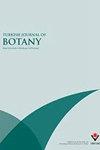Nuclear DNA content and ploidy levels of living apple germplasm collection in Türkiye
IF 1.5
4区 生物学
Q3 PLANT SCIENCES
引用次数: 0
Abstract
One of the key uses of flow cytometry is the estimation of nuclear DNA content and ploidy level, which has proven a reliable and effective approach in many studies. The primary goal of this research is to estimate the nuclear DNA content and ploidy level of the apple genetic resource collection maintained in the Fruit Research Institute?s living Malus collection for the first time using flow cytometry (for autochthonous varieties). Fresh apple leaf tissues were used for the flow cytometry analysis. For each genotype, nuclear DNA analysis was performed on three individual plants. Propidium iodide (PI) is used as a fluorochrome. Common vetch (3.65 pg/2C) was used as an internal standard. The 2C nuclear DNA content ranged from 1.46 pg to 2.45 pg. The variation in nuclear DNA content within the collection was statistically significant. Apple genotypes were split into two groups, diploid and triploid, according to their nuclear DNA content. Based on these results, 16.47% of apple genotypes were triploid, while 83.53% were diploid. The 2C nuclear DNA content in triploid genotypes varied from 2.04 to 2.45 pg and in diploids from 1.46 to 1.69 pg. The average nuclear DNA content in diploids was 1.56 pg, whereas it was 2.29 pg in triploids. The results of the study will be useful to determine the best strategies in breeding programs, as ploidy is one of the most important characteristics to consider in selecting parents for breeding purposes in addition to their agronomic characteristics.活体苹果种质资源收集的核DNA含量和倍性水平
流式细胞术的关键用途之一是核DNA含量和倍性水平的估计,这在许多研究中被证明是一种可靠和有效的方法。本研究的主要目的是估计果实研究所保存的苹果遗传资源的核DNA含量和倍性水平。第一次用流式细胞术采集活苹果(本土品种)。用新鲜苹果叶组织进行流式细胞术分析。对于每种基因型,对三株单株进行核DNA分析。碘化丙啶(PI)用作荧光染料。内标选用普通紫薇(3.65 pg/2C)。2C核DNA含量变化范围为1.46 ~ 2.45 pg,收集的核DNA含量变化具有统计学意义。根据苹果核DNA含量,将苹果基因型分为二倍体和三倍体两组。结果表明,苹果基因型中三倍体占16.47%,二倍体占83.53%。三倍体基因型的2C核DNA含量在2.04 ~ 2.45 pg之间,二倍体基因型在1.46 ~ 1.69 pg之间,二倍体基因型的平均核DNA含量为1.56 pg,三倍体基因型的平均核DNA含量为2.29 pg。本研究的结果将有助于确定育种计划的最佳策略,因为除农艺性状外,倍性是选择育种亲本时考虑的最重要的性状之一。
本文章由计算机程序翻译,如有差异,请以英文原文为准。
求助全文
约1分钟内获得全文
求助全文
来源期刊

Turkish Journal of Botany
PLANT SCIENCES-
CiteScore
2.90
自引率
5.60%
发文量
31
审稿时长
6-12 weeks
期刊介绍:
The Turkish Journal of Botany is published electronically 6 times a year by the Scientific and Technological Research Council of Turkey (TÜBİTAK) and accepts manuscripts (in English) covering all areas of plant biology (including genetics, evolution, systematics, structure, function, development, diversity, conservation biology, biogeography, paleobotany, ontogeny, functional morphology, ecology, reproductive biology, and pollination biology), all levels of organisation (molecular to ecosystem), and all plant groups and allied organisms (algae, fungi, and lichens). Authors are required to frame their research questions and discuss their results in terms of major questions in plant biology. In general, papers that are too narrowly focused, purely descriptive, or broad surveys, or that contain only preliminary data or natural history, will not be considered (*).
The following types of article will be considered:
1. Research articles: Original research in various fields of botany will be evaluated as research articles.
2. Research notes: These include articles such as preliminary notes on a study or manuscripts on the morphological, anatomical, cytological, physiological, biochemical, and other properties of plant, algae, lichen and fungi species.
3. Reviews: Reviews of recent developments, improvements, discoveries, and ideas in various fields of botany.
4. Letters to the editor: These include opinions, comments relating to the publishing policy of the Turkish Journal of Botany, news, and suggestions. Letters should not exceed one journal page.
(*) 1. Raw floristic lists (of algae, lichens, fungi, or plants), species descriptions, chorological studies, and plant sociology studies without any additional independent approaches.
2. Comparative morphology and anatomy studies (that do not cover a family, tribe, subtribe, genus, subgenus, section, subsection, or species complexes with taxonomical problems) without one or more independent additional approaches such as phylogenetical, micromorphological, chromosomal and anatomical analyses.
3. Revisions of family, tribe, genus, subgenus, section, subsection, or species complexes without any original outputs such as taxonomical status changes, IUCN categories, and phenological and ecological analyses.
4. New taxa of all plants without any additional independent approaches such as phylogenetical, ecological, chromosomal, chorological and correlational analyses in addition to a detailed macro- and micro-morphological descriptions with quality field and microscopic illustrations of taxonomically important structures and identification key in the taxonomic group.
New records of all plants without any additional independent approaches such as phylogenetical, ecological, chromosomal, chorological and correlational analyses in addition to a detailed macro- and micro-morphological descriptions with quality field and microscopic illustrations of taxonomically important structures and identification key in the taxonomic group may be accepted for peer review if they contain 3 or more new records or taxonomical status update, such as lectotypification, new combinations, transfers, revivals and synonyms.
5. New taxa of algae, lichens, and fungi without any additional independent approaches such as phylogenetical, ecological, chromosomal, chorological and correlational analyses in addition to a detailed macro- and micro-morphological descriptions with quality field and microscopic illustrations of taxonomically important structures and identification key in the taxonomic group.
New records of algae, lichens, and fungi without any additional independent approaches such as phylogenetical, ecological, chromosomal, chorological and correlational analyses in addition to a detailed macro- and micro-morphological descriptions with quality field and microscopic illustrations of taxonomically important structures and identification key in the taxonomic group may be accepted for peer review if they contain 5 or more new records or taxonomical status update, such as lectotypification, new combinations, transfers, revivals and synonyms.
 求助内容:
求助内容: 应助结果提醒方式:
应助结果提醒方式:


